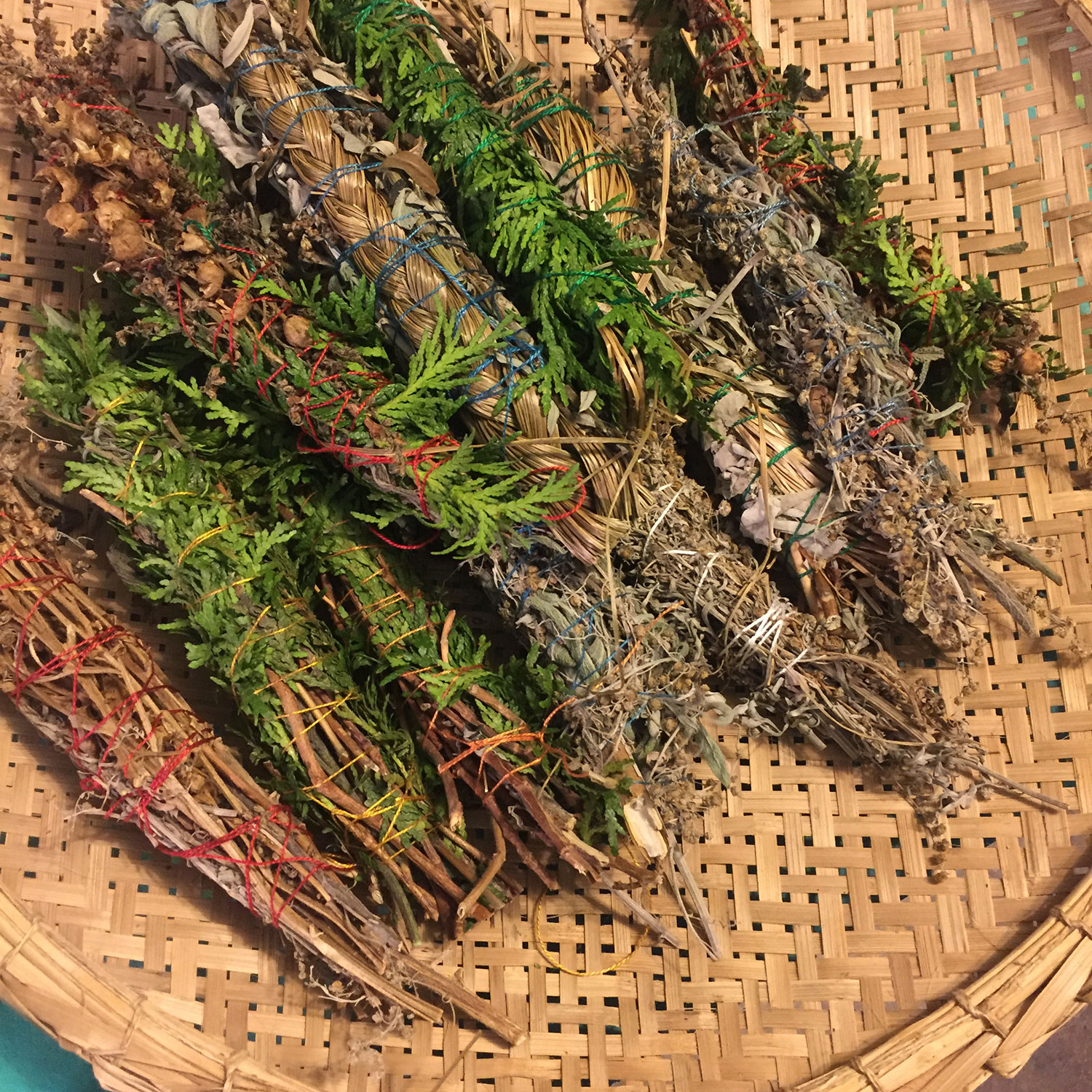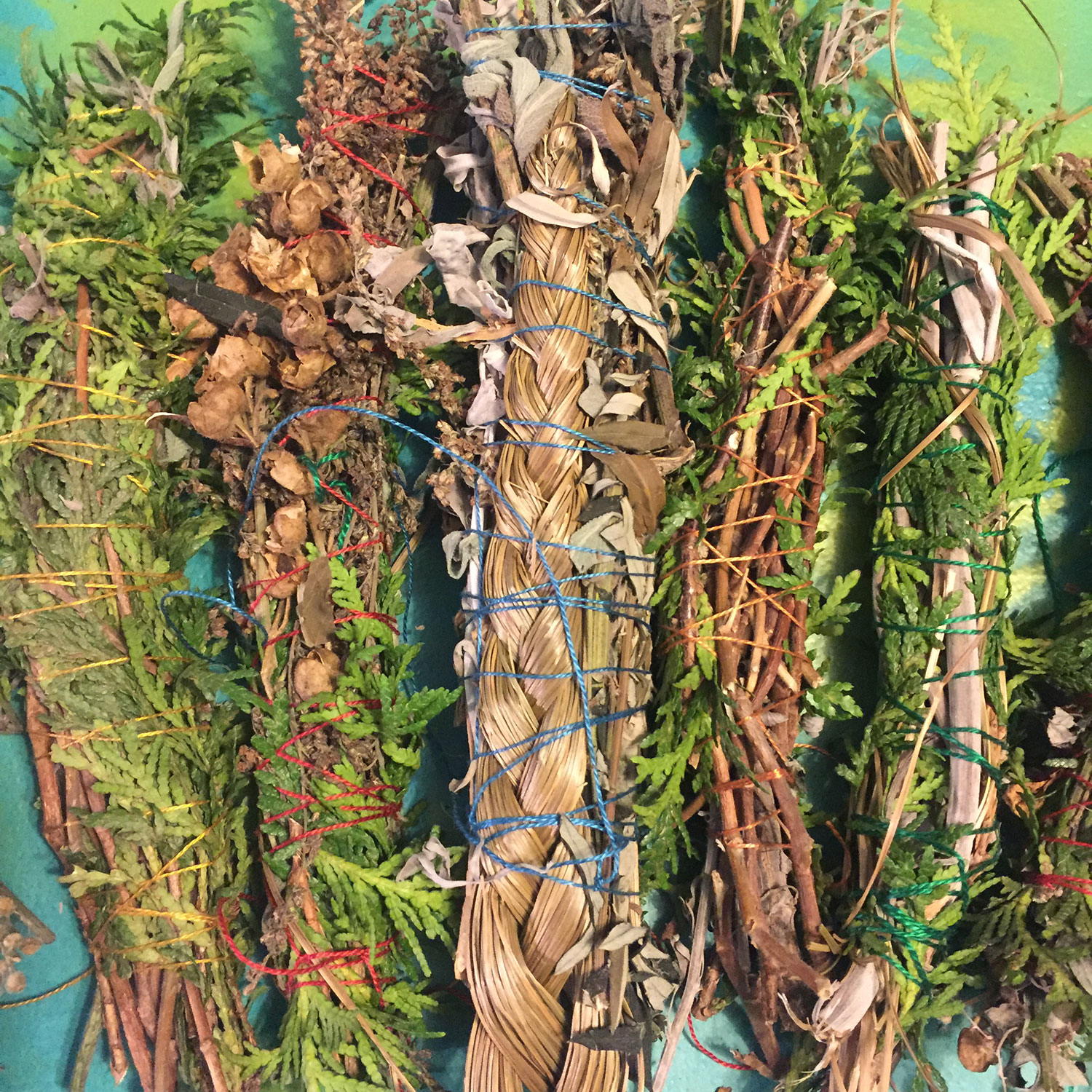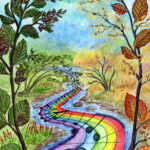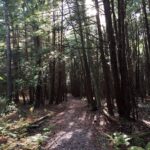
Creating homemade smudge sticks with local ingredients is a wonderful activity to do this time of year. As the plants die back, you can harvest whatever you aren’t using for other purposes and create a number of beautiful smudges that can be used for many different purposes: clearing, honoring spirits, protection, setting intentions, letting go, bringing in, preparing for ritual or mediation, and much more.
A few years ago, I wrote an initial post on homemade smoke (smudge) sticks using local ingredients–this has become my most popular post on my blog. Given that, I wanted to offer a follow-up post with some additional information and share a few smudge stick recipes for specific purposes. For initial instructions on how to make your sticks, please see my first post. This post expands the plant list that you can use to make smudges and also offers smudge stick recipes for various purposes.
Expanded Ingredient List for Smudge Stick Making
The following is a much-expanded ingredient list from my first post–it not only talks about different plants you can explore in smudge stick making, but offers their latin names and also if they can be wildharvested or need to be garden grown.
Aromatic Cultivated and Wildharvested Herbs. This list represents plants that you can easily find in the wild and/or grow in a garden. The information I’m providing is based on the US East coast/Upper Midwest, so you will need to adapt accordingly. (C) refers to the need to cultivate this herb in most places in the US Upper East Coast or Midwest, while (W) indicates you might be able to find it in the wild.
- Bay leaf (C)(Laurus nobilis): Bay has a wide range of magical uses: to banish or expel, to protect, to support, to prepare folks for deeper magical work. If you aren’t sure what to use as smudge, bay is a great choice due to its flexibility! You can cultivate bay plants; alternatively, pick up some bay leaves in the spice section of the grocery store .
- Coltsfoot (C)(Tussilago farfara): Coltsfoot is used primarily for divination, and due to its very early bloom time in the spring and beautiful yellow flower, it is also associated with sun work and the coming of spring. Leaves can be harvested in the spring or fall, you can find it along roadways in full sun or part shade areas. The leaf is large and can be used as a wrap for other smudge ingredients. The flower, looking similar to a dandelion but smaller, and blooming in early spring, can also be used in smudges.
- Eucalyptus (C) (Eucalyptus spp.)– Another herb for clearing work; its smolders nicely and produces a powerful scent. It combines beautifully with sage and lavender. You have to plant this in my region–it doesn’t grow wild, but will grow to a nice size over the summer and you can use it. You can also get whole leaf in some places if it isn’t local. While you can find it in craft stores in the US, I don’t know what they treat it with–I’d use it from an herbal supplier first.
- Hyssop (C) (Hyssopus officinalis) – An herb with ancient connections to purification work; you can also use this to keep away negativity that is thrown in your direction. Hyssop smells wonderful when burned. I’ve also used Anise hyssop in a similar way; the two do burn differently (anise hyssop is more aromatic and smells and burns like black licorice).
- Lavender (C) (Lavandula spp.) – Lavender helps with clear thinking, relaxation, and focus. You can use both leaf stalks and flower heads in smudges–lavender flowers give smudges beautiful colors and appeal. Lavender combines beautifully with sage or sweetgrass.
- Lemongrass (C) (Cymbopogon): Cleansing, removing obstacles, purification. You can grow this or even pick up stalks in the local grocery store. Burns with a lemony scent and produces good smoke.
- Mugwort (W, C) (Artemisia vulgaris) – Mugwort has a nice smell when burned (and its also used in a lot of herbal smoking blends). Mugwort is specifically tied to dreams and can produce very vivid dreaming. It is also wonderful for any other kind of trance or journeying work. While this is a powerful dreaming is a good thing in the short term, do keep in mind that vivid dreams over a long period of time can exhaust you–so use mugwort with care and not daily, but definitely use it! Mugwort also grows beautifully straight and tall, and really does do well in smudges. A lot of people cultivate mugwort, but I find it wild growing everywhere around where I live. I really love this plant for both tea (harvested young) and smudges

ingredients laid out to make some smudges–tobacco leaf and empty seed pods in front left corner. - Mullein (W) (Verbascum thapsus) – Soft, fuzzy mullein leaves have a nice “smoldering” quality–they smolder in the same way that sage smolders. They don’t smell nearly as nice, but the smoke itself does have a beneficial impact on the lungs and can, medicinally, be used for “clearing” out the lungs of toxins. In Buddhist practice, the lungs are said to house grief. I think, for a personal smudge stick where I was working to clear out some deep emotions and emotional recovery, I would most definitely put mullein in becuase of that clearing/grief/lung connection.
- Rosemary (C) (Rosmarinus officinalis) – Rosemary is another clearing and protective herb. It is also another staple for smudges. Interestingly enough, you can use both the root and the plant of rosemary–and they have different qualities. The rosemary stalks burn wonderfully in a smudge. Don’t let them get too dried out or the needles fall off easily and you will have a hard time wrapping them and keeping them intact. You might look at the different varieties of rosemary–not only do they smell slightly different, but they burn slightly different as well.
- Sage (C) (Salvia spp.) – Sage is a clearing herb that helps purify and cleanse spaces of negative energy. All sages energtically work similarly, but do have some fairly unique smells. Here are some different sage options:
- White Sage can be grown in gardens and has a potent, distinctive smell. The seeds are rather hard to start (only about a 20% germination rate) and it doesn’t like it too wet–it likes it hot. I usually plant this in my greenhouse as it is hotter and drier than the rest of my yard for the summer months. You can use white sage stalks and leaves in your smudge sticks. If you can’t grow it, you often can also find sage bundles in metaphysical shops (and you can take the bundles apart and mix them with other plants).
- Desert Sage also has a lighter, sweeter smell than white sage. I haven’t grown this myself, but have gotten some from friends who were out west. It also is relatively easy to find in the shops.
- Garden Sage is a wonderful choice for multiple purposes–culinary arts as well as smudge sticks. I harvest back the garden sage plants in the fall for use in smudges and for cooking! It has a deeper sage smell than the other two.
- Clary Sage has larger leaves and a more musky smell. Works great for smudges!
- Scented Geranium (C) (Pelargonium Spp.): Geranium is associated with prosperity, happiness, and love. The leaves and stalks of scented geraniums make wonderful smudge stick ingredients. They burn similar to the smell that the geranium has. i have had the most experience with my lemon scented geranium for smudges, but there are many options here. Pick one up and it will grow in a pot all summer for you.
- Sweet Clover (W) (Melilotus officinalis) – A great locally available plant that smells fairly similar to sweet grass (and attracts spirits and honors them, like sweet grass) is sweet clover. Sweet clover is dotted over roadsides and fields around midsummer. It does not burn quite as sweetly as sweetgrass, it has similar qualities and a similar smell.
- Sweet Grass (C) (Hierochloe odorata) – Sweet grass gets spirits’ attention and can be used any any visionary or honoring work. I cultivate a patch of sweetgrass (moved with me several times and originally given as a gift) and it works great for smudges. Sometimes, I will put a full section of a sweetgrass braid in a smudge (see my photos). That really gets some attention and looks amazing.
- Thyme (C) (Thymus vulgaris): This gentle garden and culinary herb is an incredibly powerful magical plant. Thyme helps with the removal of negative emotions, healing, and emotional healing. It looks so pretty in a smudge bundle too, especially the lemon thyme varieties.
- Tobacco (C) (Nicotinana Rustica): Home grown tobacco is my go-to offertory plant, making offerings in particular to the spirits of the land, particularly of the plant kingdom. Tobacco also helps other plants do their work better (it amplifies their power and connects you deeply with their energies). I grow my own tobacco, and I use the leaves for offerings and use the stalks in smudge sticks.
- Valerian (C) (Valeriana officinalis) – Valerian is one of the most powerful and potent cleansing and clearing herbs. A little valerian goes a long way. The fresh flowers smell sweet, but as they dry, they take on a potent wet-dog style aroma. The dried flower stalks work great in smudges. You can also use the roots, but the roots smell even more like a wet dog–and your smudge will smell similarly when burned. And your house will smell just with the roots sitting out in a smudge stick. That physical potency lends itself well to the spirit plant, for I have found nothing better to clear out a space. Burn with the windows open!
- Wormwood (C, W) (Artemisia absinthium): Another super protective and clearing herb is Artemesia Absinthium (Common Wormwood). It has a pleasant smell when it burns, and is clearing, but in a more gentle way than valerian.
- Yarrow (C, W) (Achillea Millefolium): Yarrow is another herb I like to use a lot in my smudges for its energetic qualities; it smells a lot like itself when it burns due to the high volatile oil content. Yarrow is used for workings where you don’t want to be seen or you need to hide or conceal something. It is also useful for strength and divination.
Trees and Shrubs. Traditionally, cedars (like incense cedar or red cedar) were used for smudges out in the western part of the US. In my bioregion, conifers mostly produce the best smudges, although some a few other options exist.
- Eastern Red Cedar/Juniper (Juniperus virginiana): Junpier is a strongly protective herb and useful for male strength and for banishing. This is a wonderfully aromatic plant with berries that also are used medicinally. I love using juniper in my smudges–but it has little prickly bits, so use it carefully so that you don’t get stabbed.
- Eastern White Cedar (Thuja Occidantalis): Eastern white cedar is a great smudge to help cleanse and open up a sacred space. It also helps with cleansing negative emotions, grief, or other pain. It is also tied to longevity and illumination. Eastern White Cedar crackles and pops when it is freshly dry due to its high amount of volatile oils. If you use the cedar branches when they are first dried, they smell wonderful but literally crackle and pop when you burn them due to all of the volatile oils—which is a bit of a fire hazard, but also can kind of be fun. However, if you hang the cedar in your house for a few months and let it dry out, the oils slowly dry out of the cedar and then you can make your smudge sticks. The sticks at this point will smoke beautifully.
- White Pine (Pinus Strobus): White pine is associated with peace (both outer and inner), drawing things out (including pain), cleansing and purification, and wayfinding. White pine needles burn beautifully and smell a bit like a pine-vanilla when they burn. Wonderful in any smudge stick!
- Blue Spruce (Picea pungens, Picea glauca): Spruce offers healing, resilience, strength, getting past the darkness. The latin name says a lot about the scent of the spruce tree: pungens – it is pungent! The blue spruce has a very musky smell which goes well for working with animal magic and other nature-focused approaches. The white spruce is less musky and very strengthening and potent. Beware–most spruce needles are sharp and may need to be handled carefully when harvesting and making smudges.
- Staghorn sumac(Rhus Typhina): Staghorn sumac is a wonderful addition to any smudge stick. While you can use the leaves or fuzzy berry clusters, I much prefer the berry clusters. If you are using the leaves, you need to get them into the center of the smudge stick or they crumble as they dry. You can make smudges with small clusters of berries and or collect and use the leaves after they have gone red in the fall for the best smoke. Staghorn sumac has a very calming effect (I use it as an herbal smoke for my bees) and smolders nicely–plus, it is a beautiful red color that provides visual beauty in your smudge. It has a fairly pleasant smoke (not very aromatic, but copious). Staghorn sumac is a plant that offers creative approaches to thinking and cunning, which can certainly be of use.

Visual Components. There is also a visual component to making a nice smudge stick, and I think this is where various wild flowers can lend a hand. Most of the flowers don’t have a particularly strong smell when burned, but a bit of purple or yellow or white in your smudge can look absolutely beautiful (and add energetically to your smudge). A visit to any flower field in the height of the summer will certainly give you much to work with–I love adding black eyed susans, sprigs of blue queen sage, or yellow ox-eye daies to smudges. You can also cultivate flowers like statice or baby’s breath which hold their beautify for long periods of time for your smudges (I would not buy these commercially as they are almost always sprayed with something you don’t want to make airborne). There are SO many options to experiment with!
Recipes for Smoke Clearing Sticks
Now that we have so many wonderful ingredients to choose from for home-grown smudges, what kinds of combinations smell nice and work well? The following are some combinations I have used for various purposes. You may not have all of the ingredients on these lists–you can eliminate ingredients you don’t have and mix and match. In the end, your intuition should be the best gauge for what plants to put together for what purposes. Here are some of my personal favorites:
Recipes for the Wheel of the Year
- Winter Solstice Smudge: For bringing the light back into the world. Cedar, Juniper, and White Pine.
- Imbolc Smudge: For Purification and Renewal: Hyssop, Rosemary, Cedar, and Sage
- Spring Equinox Smudge: Letting the Awen Flow: Lavender, Sage, and Cedar
- Beltane Smudge Smudge: Fertility: Wormwood, Motherwort, Lavender
- Summer Solstice Smudge: Drawing Strength and Power: Scented geranium, wormwood, juniper
- Lughnassadh Smudge: Land blessing/Offering: Tobacco and White Pine
- Fall Equinox Smudge: Seeking Balance: Bay, Rosemary, Mullein, Thyme, and White Pine
- Samhain Smudge: Honoring the Ancestors – Bay, Sweet Grass or Sweet Clover (or both), Cedar
Recipes for Other Purposes
- Visioning and Journeying Smudge: Any of the following, individually or in combination: Mugwort, Bay, Lavender, Sweet Grass, Sweet Clover, Yarrow, White Pine, Staghorn Sumac
- Letting Go of Grief/Pain: Mullein, Juniper, Thyme, White Pine
- Really Super Cleansing: Valerian, Rosemary, Wormwood
- Divination: Coltsfoot, mugwort, White Pine
- Establishing Sacred/Ritual Space: Bay, Yarrow, Sage, Cedar, Staghorn Sumac




Reblogged this on Paths I Walk.
Thanks for the reblog!
Reblogged this on Good Witches Homestead.
Thanks for the reblog!
My pleasure.
Packed with valuable info! Thanks!
Thanks for reading, Kieron!
Reblogged this on GrannyMoon's Morning Feast.
Thanks for the reblog!
My pleasure!
Thank you, Dana. I recently made my first smudge stick with your directions from a previous blog and it went well. Now I have more recipes to use. I love your ideas.
Great! I’m glad the smudges are working out so well for you 🙂
Reblogged this on Rattiesforeverworldpresscom.
This is great. I’ve used sweetgrass, red cedar, and various artemisias (mostly the white prairie sage that is native here, Artemisia ludoviciana), and knew some others could be used, but just haven’t used them. After reading this I will definitely get more creative with my smudge bundles. We have a different sumac species here, either smooth sumac or fragrant sumac — I think both grow here, just not sure which one I’m surrounded by. Do you think these can be used in place of the staghorn? When you wrote about using flowers, asters were the first to come to mind. They’re quite abundant here, especially in late summer and fall, various species.
Definitely worth a reblog! Great info. Thanks! https://wallflowerstudiogarden.com/2018/11/18/home-grown-and-wildcrafted-smudge-sticks-plant-list-and-recipes/
Thanks for the comment and reblog!
My pleasure, Dana. Very much enjoy following the Druid Garden! Have a lovely week.
I was just talking about making smudge sticks yesterday. This article is really helpful. Thank you.
You are most welcome! I hope you get to make some great smudges!
I am in Australia so the plants are coming into flower now. I will bookmark your post so I can come back to it at harvest time. It’s very helpful.
Reblogged this on *Ancient Healing Arts* and commented:
Smudge sticks are the easiest and one of the most enjoyable forms of incense to make (no special skills required besides being able to identify plants). This blog post contains a rather extensive list of botanicals you can use for making smudge sticks but I’ve used other plants as well.
Great info! Thank You! Loving your blogs.
Glad you enjoyed! Thanks for reading 🙂
Re-Shared on [FB] “Wildcrafting, Gardening, and Herbalism”. Great article!
Thank you, Eric!
Greetings! Thank you for this interesting and informative article. I put a 🌟 on it and bookmarked it for future reference. I will definitely be using it to guide and inspire me.
I appreciate your work and I would like to follow you in future posts.
Debra
Thank you, Debra! You might also look at the archives–this blog is almost 7 years old, so there is a lot of good stuff to read :).
Wow! Such a cool blog. So much good information to read about. Thanks.
Thank you!
[…] posts that I recommend reading on the topic of smudge sticks: the 1st one explains the basics, the 2nd one goes more in-depth regarding which plants can be used. Of course, it does require some basic herbal […]
Excellent post
[…] https://thedruidsgarden.com/2018/11/18/home-grown-and-wildcrafted-smudge-sticks-plant-list-and-recip… […]